




I feel at home in the natural world but will always lean towards extreme landscapes, those places where nature makes you sit up and notice and that feel just a little bit more intense. And so I prefer my sand in a raw red desert than on a pristine white beach. A sunny beach is eager to please, but the desert challenges you to take it on. It’s a forbidding landscape but one that is sublime in its solitude, starry skies, stillness and space.
My first taste of the desert was intoxicating. I was in Australia’s Northern Territory where the hot air felt like a slap and the red earth looked like a firestorm. Having spent most of my life up until that moment on the northeast coast of Scotland, it was a sensation that felt utterly out of my then-small world. That sensation, and the desert, have tugged at me ever since.
The desert can be brutal, and without suitable shelter it will devour you. Building a shelter in an extreme landscape with limited resources is demanding, and yet, there’s something about the challenge of a desert that inspires creativity. In the following pages you’ll journey round deserts from the Gobi in Mongolia

to the Atacama in Chile and discover accommodation as diverse as the landscapes. Some take their cues from their cultural environment, such as terracotta domes inspired by the traditional homes of the indigenous Himba of Namibia. Others take their inspiration from the surrounding flora-the exterior of a contemporary cabin that utilises the design of a tough endemic plant, for example. Many are concerned with making as gentle a footprint on the earth as is possible-such as light-touch tented villas that can be removed without a trace. And then there are those that evoke nostalgia for the past or the hope for a bright future, from renovated mid-century Airstreams to glass pods that look as if they’ve just touched down on a new planet.
While these escapes are far from simply places to lay your head and each is worth the trip alone, all are in locations that demand to be explored. In each of the following escapes, curious travellers will find opportunities to forge a deeper connection with their surroundings, whether by camel trekking over dunes, observing desert-adapted wildlife, or simply watching the sun dip below a sandstone arch.




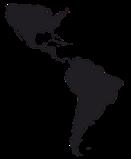

Namibia +264 61 427 200
gondwana-collection.com

There’s seclusion and then there’s Desert Whisper, an intimate, oneof-a-kind desert hideaway for two. Resembling a spaceship that has touched down onto a rocky outcrop in one of the driest places on earth, this pod-shaped villa is one of just a handful of accommodation options in the private Gondwana Namib Park in the Namib Desert. Part of the sustainability-focused Gondwana Collection Namibia, it is perched above the desert sands in stark terrain about an hour’s drive from Sossusvlei.
As otherworldly as Desert Whisper may appear, its eye-catching design was inspired by nature. Architect Sven Staby drew inspiration from the Namib’s hardy endemic nara plant, which has a tough, leafless outer skin that can survive the
harsh desert climate. This quality is reflected in the hard, curved metal exterior of Desert Whisper, which protects the soft, smooth interior where natural colours, materials and shapes similarly reflect the surrounding environment. Views from the enormous floor-to-ceiling windows take in the golden expanse of the Namib all the way to the horizon, fringed by the Naukluft Mountains in the distance.
Designed as a luxuriously intimate desert escape, Desert Whisper can only be booked for two people. You and your partner have exclusive use of the open-plan kitchen, dining and lounge area and plunge pool, which are connected to the villa by a snaking wooden walkway. Meals are prepared in advance according to guests’ preferences
and staff stay away as much as possible to ensure privacy (but are always within contact by radio). It’s quite possible to spend days here encountering no other life but the passing oryx, jackal and ostrich, the only sound the soft whispers of the desert wind.
You could easily spend those days bouncing between the pool and terrace, refilling glasses of South African wines and gins from the fully stocked bar, but if you do feel like emerging from your desert hideaway, outdoor adventures abound. You can embark on a guided drive through the awe-inspiring Namib-Naukluft National Park, home to towering red sand dunes and the pans of Deadvlei and Sossusvlei, or rent an e-bike, grab a map and pedal your way towards the Naukluft Mountains.
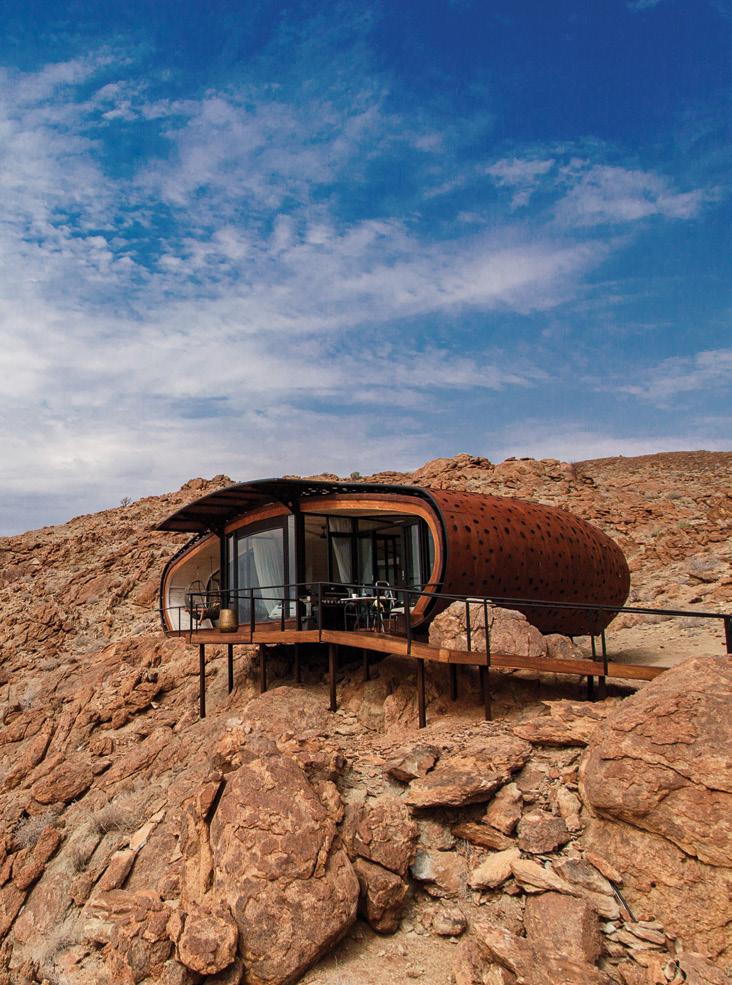
Couples’ getaways don’t get more romantic than at this intimate escape in the midst of the Namib sands.
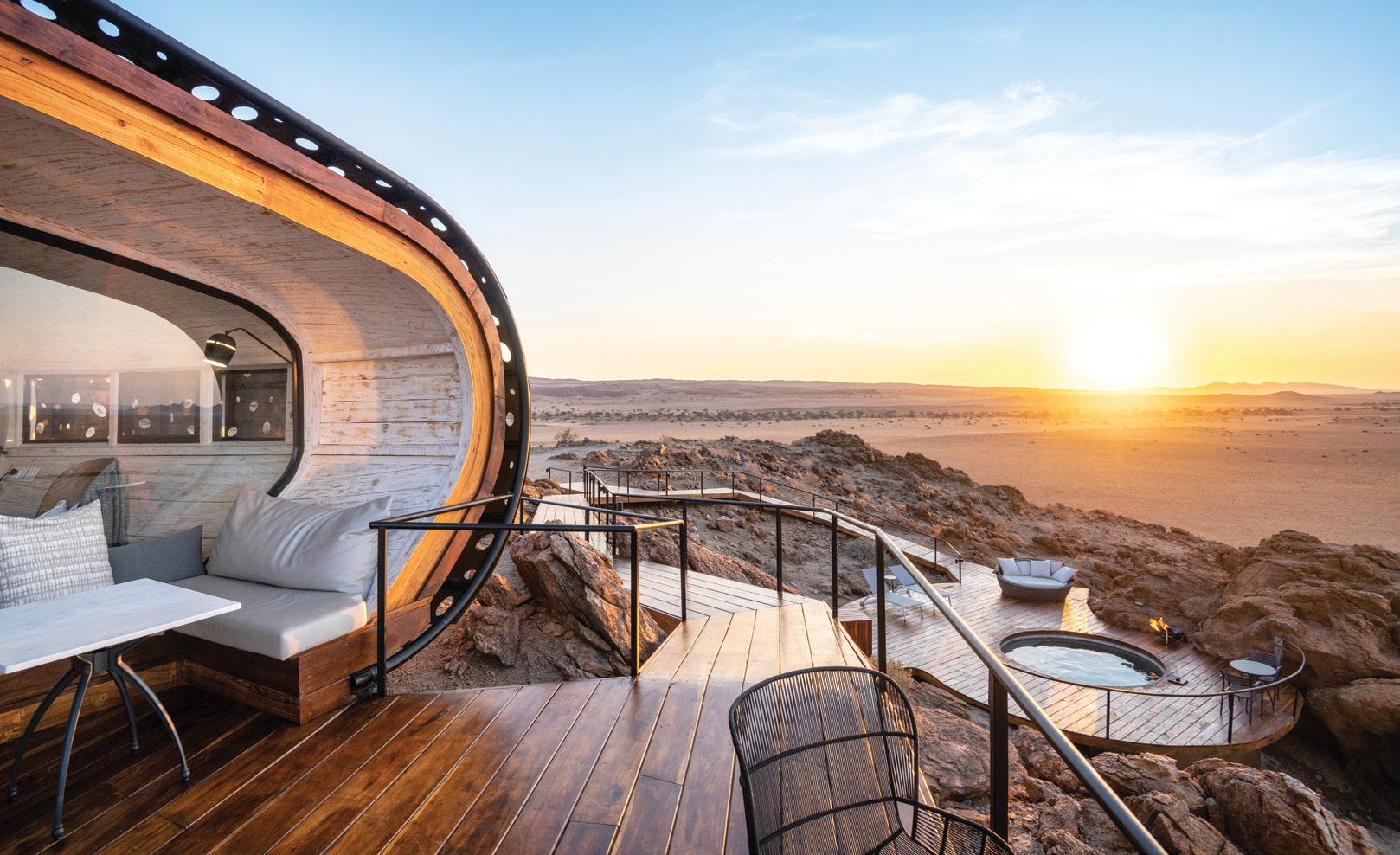

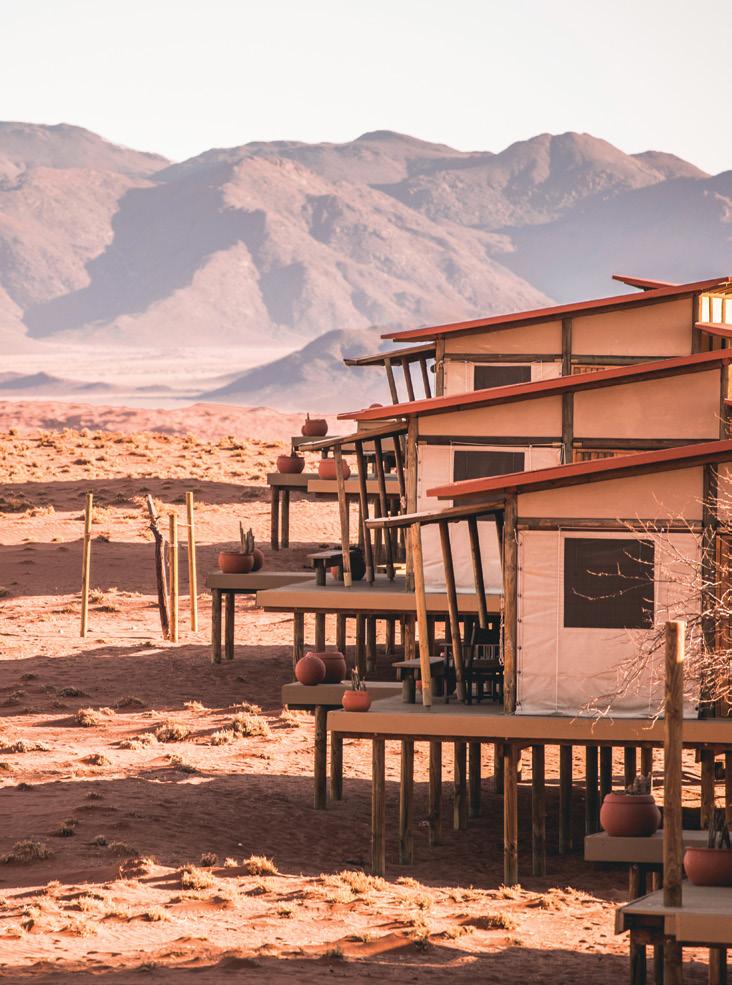
NamibRand Nature Reserve
NamibRand Nature Reserve C27
Namibia +264 61 230616
wolwedans.com

In the Namib Desert, in the heart of the private NamibRand Nature Reserve, Wolwedans is so much more than simply a collection of timelessly elegant desert camps and villas. This is a place thoroughly committed to its founding ethos: to set an example in sustainability and fulfil its commitment to the conservation of the stunning nature reserve and development of its surrounding communities.
The Wolwedans Collection is comprised of three camps and two exclusive-use villas. Your options range from the four-room Plains Camp villa (the most exclusive one) to the down-to-earth, six-tent, Dune Camp. At the unique Desert Lodge, which has nine chalets, you can sleep just that little bit more soundly in the knowledge that you are helping to support the economic resilience of the community. Formerly known as Dunes Lodge, Desert Lodge
camp has been reinvented as the collection’s hospitality training facility, part of the Wolwedans Desert Academy based at the village at Wolwedans. That means that the friendly young staff you encounter are getting practical, real-world experience in the hospitality business. Service might not always be 100 per cent seamless, but it will always be enthusiastic. It’s all part of Wolwedans’ vision for more inclusive conservation tourism that supports communities - an ethos any traveller with a conscience should easily be able to support.
Ultimately, though, you’re here for the views. And Desert Lodge does not disappoint. Raised on platforms and stretching across a dune plateau, the chalets are all spaced apart to maximise privacy and designed so that bedrooms and bathrooms look out over the veranda to the desert and mountains-sleep
with your canvas blinds open for the soft sensation of the evening breeze and sight of the starstudded sky. A variety of communal recreation spaces offer plenty of options whether you’re seeking solitude or ready to mingle: there’s a spacious main area consisting of two lounges, several sundowner decks, a fireplace, a tea deck, a library, wine cellar and two dining rooms where you’ll enjoy mouth-watering meals accompanied by excellent wines. The sparkling swimming pool is suspended above the dunes behind the lodge with 360-degree views.
Wherever you choose to spend your nights, daytime activities include bushman-led nature walks through the NamibRand Nature Reserve to learn about its desert-adapted flora and fauna; e-biking and horse-riding over the dunes, hot-air balloon rides; and scenic flights to the Diamond Coast.
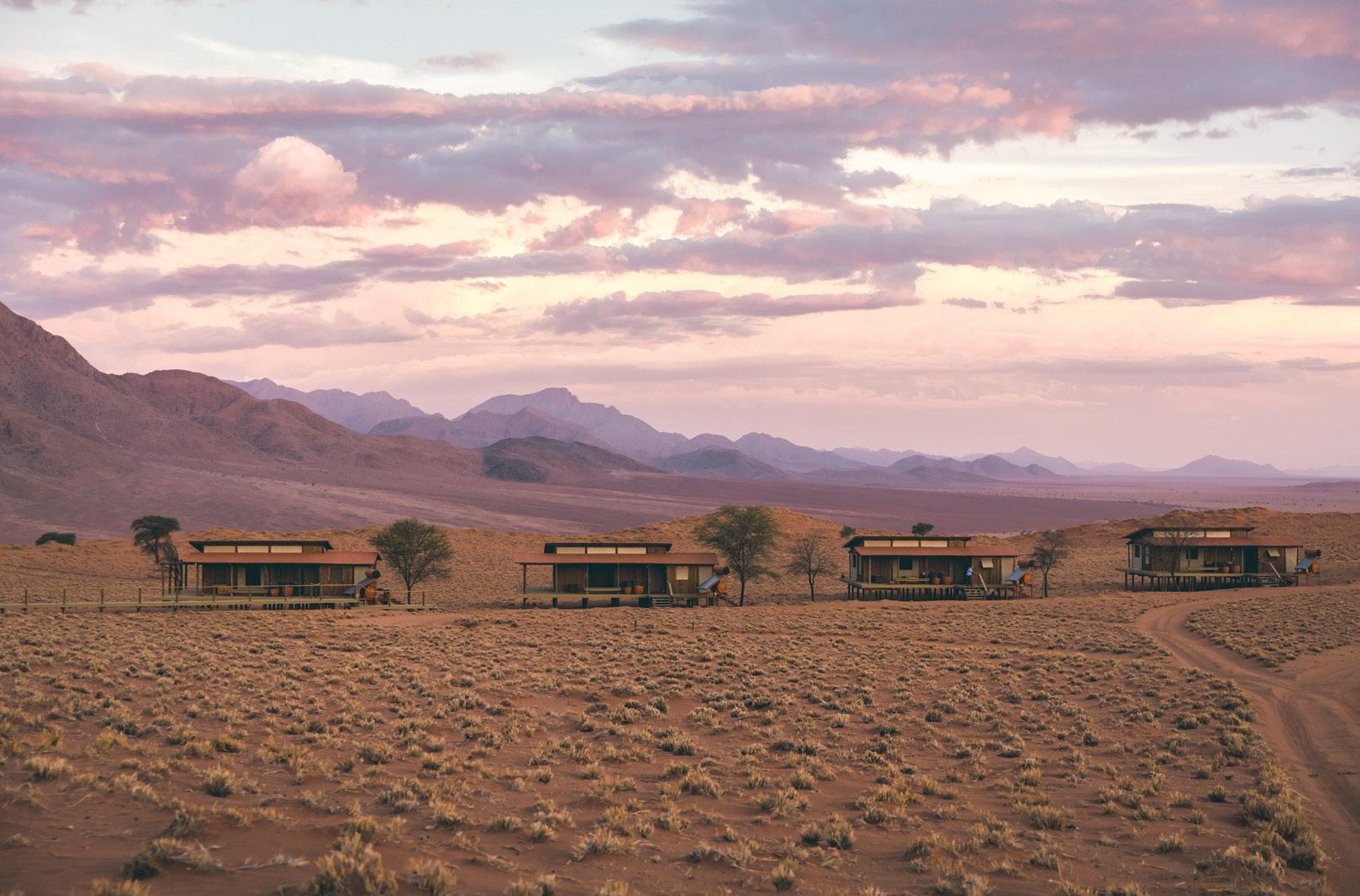

Namibia +264 61 274 500
wilderness-safaris.com
You can’t get much closer to the iconic Sossusvlei sand dunes than Little Kulala. Situated in the 67,000-acre (27,000-hectare) Kulala Wilderness Reserve, in Namibia’s hauntingly desolate Namib Desert, the lodge offers spectacular views of the famous burnt-orange dunes to the north; rugged mountains to the west, and vast open plains and the enigmatic grass-ringed formations known as ‘fairy circles’ in between. And with its own private entrance to Namib Naukluft Park, it’s as secluded as it gets.
The entirely solar-powered camp’s 11 spacious kulala lodges (meaning ‘to sleep’ in the indigenous Oshiwambo language) blend in effortlessly with their surroundings thanks to their soft, earthy desert tones and textures and use of local natural materials. Each has floor-to-ceiling windows from which to view the ever-shifting
landscape and spot passing desertadapted wildlife such as ostriches, springbok and oryx, as well as the occasional brown hyena. Villas have private plunge pools and rooftop terraces that invite sundowners and stargazing or even (in the warmer months) a sleep out under the clear Namib sky. The elegant main lodge includes a library, wine cellar, craft boutique, dining area and lounge, and overlooks a watering hole popular with oryx, springbok and birdlife.
Little Kulala is operated by Wilderness Safaris, which runs dozens of luxury camps in remote, wildlife-rich wilderness areas across the African continent, each with an emphasis on sustainability. When the company arrived in the area about 25 years ago, many years of subsistence goat farming had left very little surviving indigenous wildlife. Today, with careful
rehabilitation, the land and its wildlife are back to their former glory and the Kulala Wilderness Reserve is nicknamed ‘the living desert’ because of its rich biodiversity.
See the desert come to life by embarking on an early morning excursion through the camp’s exclusive entrance to the towering Sossusvlei dunes, including the famed ‘Big Daddy’, which stands just over 1,000 feet (325 metres) above the valley floor, making it one of the tallest dunes in the world. The camp offers guided flora and fauna walks along mountain and riverbed trails and scorpionspotting night walks, as well as nature drives and electric bike and low-impact quad bike rides across the sand. There is also a seasonal sunrise hot-air balloon flight over the dunes, which ends with a delightful champagne breakfast.
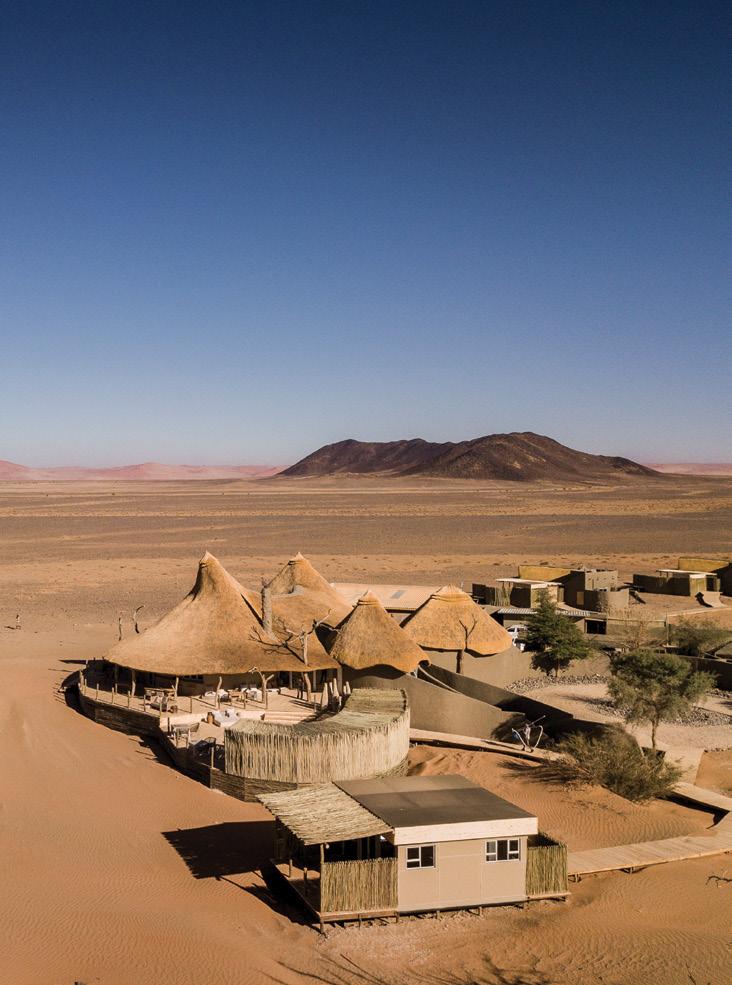
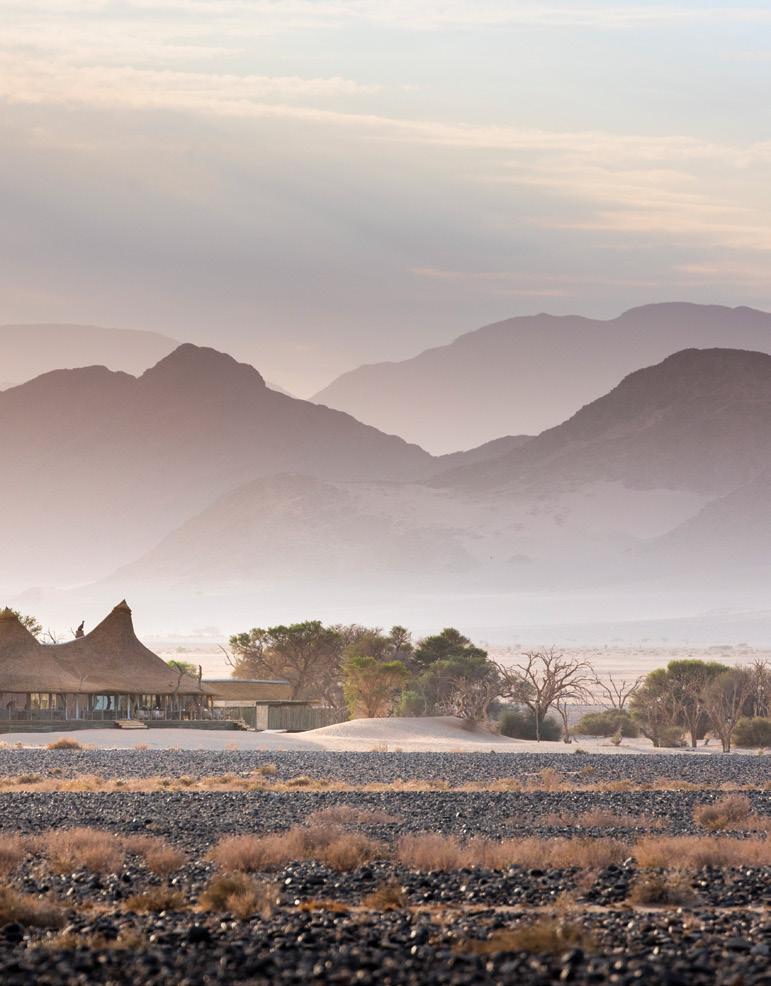
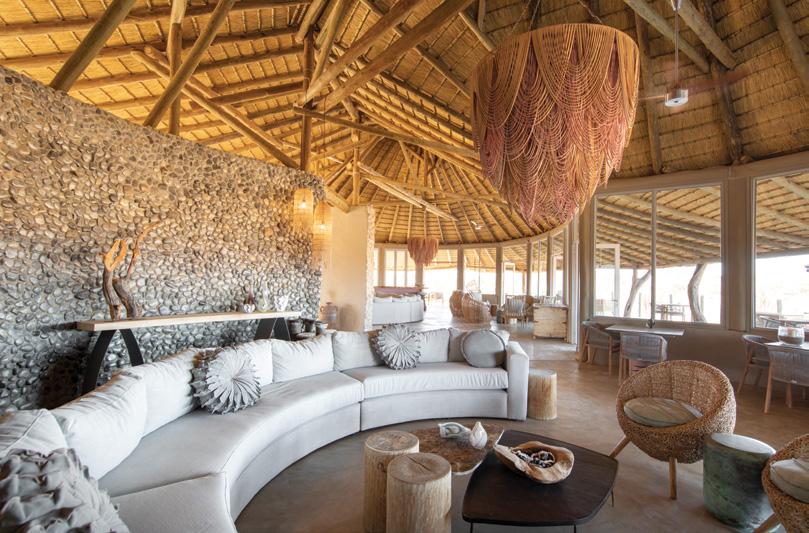


Rare wildlife and traditional culture draw adventurous visitors to one of Namibia’s most remote lodges
Kaokoveld Desert
Purros Conservancy in the Kunene Streek, Purros
Namibia +264 61 237 294
okahirongolodge.com

There’s remote and then there’s Kaokoland, a harsh, desolate, extreme, and dramatically beautiful region in the far north of Namibia that is considered one of Africa’s few true remaining wildernesses. If you can make it there, you’ll find one of the most original places you’re ever likely to stay in: Okahirongo Elephant Lodge, in the Purros Conservancy, a 2.5-hour private flight or 12-hour 4x4 drive from Windhoek.
Perched on a hill above the banks of the Hoarusib River, at first glance the lodge, with its dramatic dome, resembles a James Bond villain’s lair. The architecture of the lodge and its seven terracotta suites may appear unconventional, but they draw inspiration from the traditional homes of the semi-nomadic Himba, the region’s indigenous people. And
Africa | Namibia
the design is not the most striking thing about the suites-save your astonishment for the views. From every angle, even while soaking in the huge bath, you get an eyeful of the Hoarusib River below and the jagged peaks of the Purros Valley Mountains in the distance. Turn your attention inside and the interiors won’t disappoint either: each suite has four-poster beds and private terraces with enormous sunloungers where you can sleep under the stars, and warm colours and textures throughout that echo the landscape. There’s also one family suite with two bedrooms and the lodge has an infinity-edge swimming pool with views of the distant mountains. Meals are served in the open-air dining room and the menu is a fusion of Italian and African flavours prepared with ingredients
that are mostly grown in the lodge’s organic gardens. After dinner, you can gather round the fire and swap stories with the few other guests in the traditional boma.
But if you’re staying at a place with ‘elephant’ in its name, you’ve probably come for the wildlife. Morning and afternoon game drives take you out in search of rare desert-adapted elephants, black rhino and lions, as well antelopes, giraffes, ostriches and zebras. The lodge also organises morning desert walks and visits to a nearby village where you can learn about the culture of the Himba. Staff can arrange a picnic lunch in the Hoarusib Valley after visiting the area’s captivating ‘clay castle’ formations, and set up postadventure sundowners on dunes overlooking the Skeleton Coast.
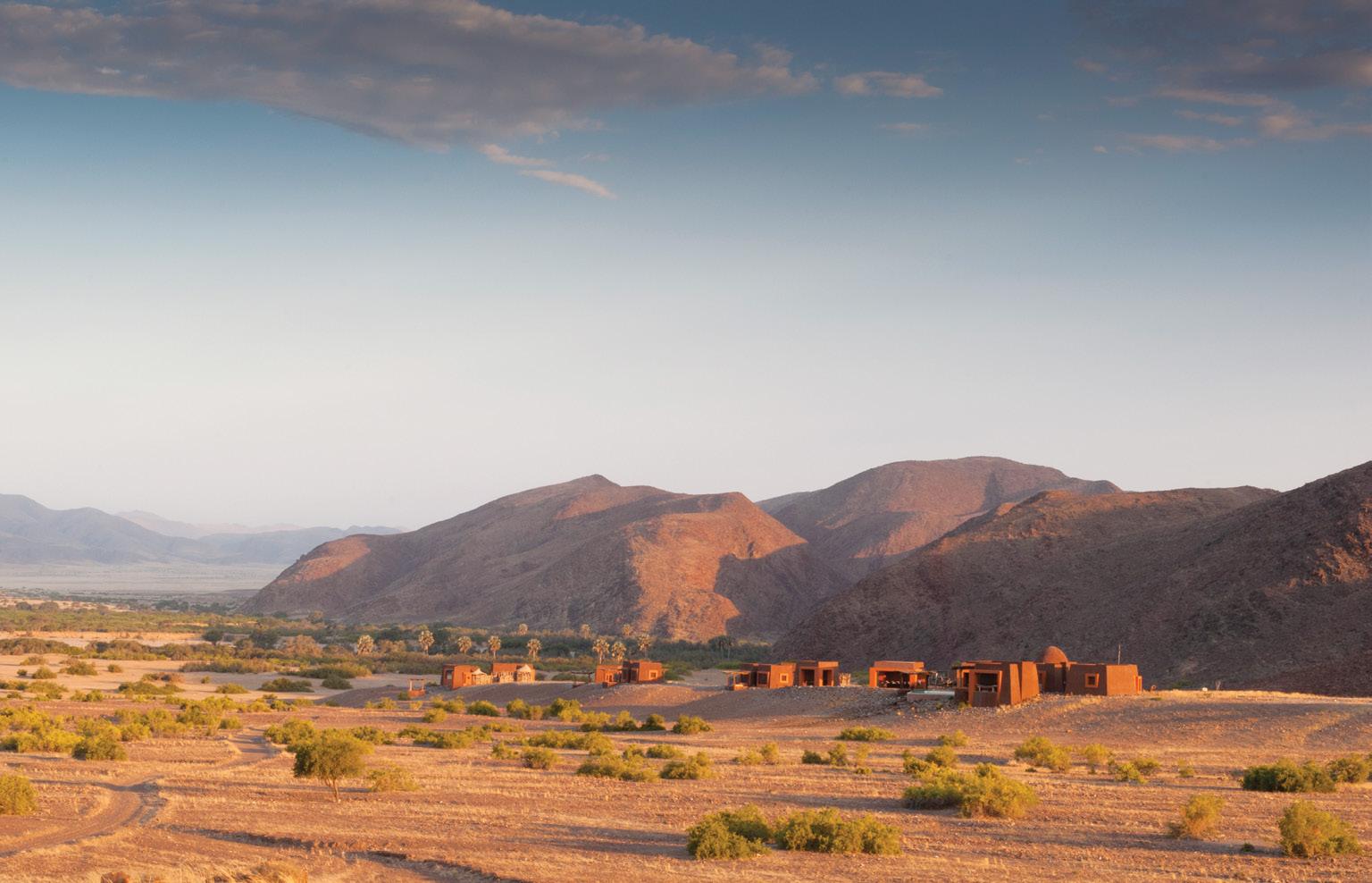

Words and Concept: Karen Gardiner
Design: Carolina Amell
Editing: Léa Teuscher
Sign up for our newsletter with news about new and forthcoming publications on art, interior design, food & travel, photography and fashion as well as exclusive offers and events. If you have any questions or comments about the material in this book, please do not hesitate to contact our editorial team: art@lannoo.com
©Lannoo Publishers, Belgium, 2023
D/2023/45/20 – NUR 500 / 450
ISBN 978 94 014 8870 9
www.lannoo.com
All rights reserved. No part of this publication may be reproduced or transmitted in any form or by any means, electronic or mechanical, including photography, recording or any other information storage and retrieval system, without prior permission in writing from the publisher.
Every effort has been made to trace copyright holders. If however you feel that you have inadvertently been overlooked, please contact the publishers.